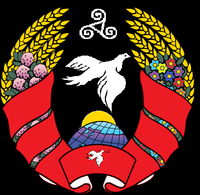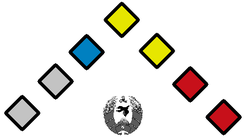National Assembly (Leylandiistan)
National Assembly of Leylandiistan Tionól Náisiúnta an Léiloindístáin (ga) | |
|---|---|
| Democratic Republic of Leylandiistan | |
 | |
| Type | |
| Type | Unicameral legislature |
Term limits | 2 years |
| Leadership | |
President | |
Vice-President | Ruairí de Créag, Centralist Democratic Party of Leylandiistan since August 2013 elections - August 2014 disbanding |
| Structure | |
| Seats | 7 Assembly Members |
 | |
| Elections | |
Last election | 2013 Leylandiistan General Elections |
| Meeting place | |
| National Assembly Room, Maple Hill, Robinscourt | |
The National Assembly of Leylandiistan was the legislature of the Democratic Republic of Leylandiistan. It was founded following Leylandiistan's independence in 2012. The first two members were Ruairí de Créag and Fionnbarra Ó Cathail. However, as more citizens joined, the size of the government grew and grew. After the 2013 general election the National Assembly had 7 members: The President, Vice President and 5 secretaries or MNAs (Member of the National Assembly). The first election in Leylandiistan's history elected that government in August 2013. In the historic election, 75% voted, and all seats in the assembly were filled. However, the constitutional referendum of 2014 changed the layout of the legislative branch, and the National Assembly changed yet again.
Layout of the Assembly, November 2012 - August 2013
The National Assembly was created upon independence in November 2012. A power sharing agreement was negotiated by the two founders, Fionnbarra Ó Cathail and Ruairí de Créag. They both immediately took office as Co-Consuls of Leylandiistan. The first cabinet meeting was on 10 November 2012, just a week after independence. At the time, there were only two government members, Ruairí de Créag and Fionnbarra Ó Cathail. They were also the only MNAs. Minutes were taken at the first two cabinet meetings, after that, most meetings consisted of casual discussion, and rarely consisted of formal meeting procedure. The population of Leylandiistan grew, and the Co-Consul power sharing agreement was due to terminate as soon as a president had been democratically elected. Elections were scheduled for June 1, 2013, but were later delayed continuously, until at the end of July general elections for National Assembly seats and executive offices were scheduled for mid-August.
Layout of the National Assembly, August 2013 - March 2014
Fionnbarra Ó Cathail was elected President, and Ruairí de Créag was elected Vice President, in the elections of August 2013. Not long after, the inauguration ceremony was held in the capital Maple Hill. Oddly enough the inauguration was held in Assembly Hall, where the first ever Cabinet Meeting had been held. In November 2013, the National Assembly passed it's first ever legislation. The Installation of Legislative and Executive Powers Act 2013 ) was accepted by 6 of the 7 members. This Act put the powers of the National Assembly and the President and Vice President in writing. The Foreign Policy Act 2014 was passed in January 2014. The last two months of the National Assembly in that format were notoriously inactive, and a Justice Act proposed by Ruairí de Créag failed to be approved due to a lack of votes. Change was needed, and so a constitution was drafted by the Executive Council and approved by referendum.
Members of the National Assembly (MNAs)

Red:SALDAL
Yellow:Centralist Democratic Party of Leylandiistan
Blue:Republican Party
Grey:Independents
The first members of the National Assembly were:
- President Fionnbarra Ó Cathail, leader of SALDAL. (Secretary for Foreign Affairs, Internal Affairs and Religious Affairs)
- Vice President Ruairí de Créag, Leader of CDP. (Secretary for Finance, Health, Sports, the Arts, Public Order and Law)
- Norma O'Connor, deputy leader of SALDAL. (Secretary for Education, North American Affairs, Transport and Communications)
- Ursula O'Sullivan, deputy leader of CDP. (Secretary for Entertainment, Tourism and Culture)
- Gerard O'Sullivan, Independent (Defence Secretary)
- Austin Rowe, Republican Party Leader (Social Welfare secretary)
- Hugh Murray, Independent (Secretary for Environment, European Affairs and Construction)
Electoral rules and procedure
Every citizen was asked whether or not they would stand in the election. Then the Electoral Commission designed a ballot paper. It contacted all the citizens several times before and after the election, regarding rules and results respectively, as well as informing people when the ballots were to close.
Whoever received the most first preference votes was elected President. The person who received the second highest amount of first preference votes was elected Vice-President. Then the next 5 most popular candidates were elected to the national assembly as Secretaries or MNAs (Member of the National Assembly). However, the capacity of the National Assembly could fluctuate. The National Assembly only met to vote and debate legislation when necessary. Any member could propose legislation. Unlike most parliamentary systems, there was no opposition; instead, each Assembly member was given a ministerial portfolio. This system meant that all members of the National Assembly were in the government. This method is rather undemocratic, given there was no official opposition in the Assembly, there was no way for the Assembly's activities to be scrutinised. This is also a factor in what caused this format of the National Assembly to suffer from inactivity.
Executive Council
Although the National Assembly did not meet regularly, the Executive Council did. This council consisted of just two members; The President and the Vice President. It met every fortnight on average. It's duties included small functions such as setting up small state bodies and companies, reviewing legislation and statistics, reviewing affairs of other micronations and macronations, and recommending legislation. Past actions of the Executive Council included the setting up of Leylandiistan Beverages, Leylandiistan Post, LeylandiiCell Telecom and the National Aerobics Society of Leylandiistan, as well as managing social media presences and helping the fledgling tourism sector.
Layout of the National Assembly, March - July 2014
After the constitutional referendum, many changes occurred. Direct democracy was introduced through the means of Regional Councils. Every citizen sat on their local regional council, which functioned as a legislature for each autonomous republic, and as a debating chamber for national legislation. Each Regional Council nominated one of its members to represent them in the National Assembly. As there were only two regional councils, there were only two members of the National Assembly. The Executive Council was disbanded, but the executive branch continued to exist and meet informally. Unfortunately, following the referendum inactivity took hold in the government, and these constitutional changes were never correctly or completely implemented. Therefore, it was only a matter of time before something major happened, and the events of 24 July 2014, where Robinscourt A.R. withdrew from the Democratic Republic of Leylandiistan (often called the Division of Leylandiistan), were subsequently seen as inevitable.
Disestablishment of the National Assembly
The National Assembly of Leylandiistan hung in limbo following July 17. The Constitution did not have any guidelines for how Leylandiistan would operate with only one constituent autonomous republic, and therefore only one National Assembly member. To resolve the deadlock, and to benefit both nations, President Fionnbarra Ó Cathail negotiated a merger with the Republic of Gurvata. The Treaty of Union was signed on 30 August 2014, disbanding the Democratic Republic of Leylandiistan and the Republic of Gurvata, and forming the Confederation of Leylandiistan and Gurvata. The treaty disbanded the legislatures of both countries in favour of one for the whole Confederation, and so the National Assembly was no more.